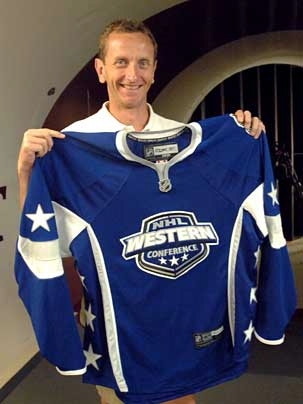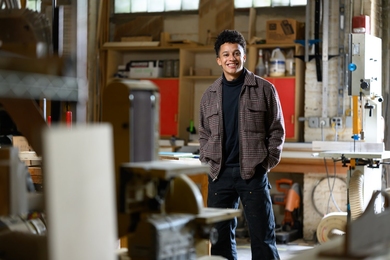Testing done at MIT is helping players in the National Hockey League (NHL) improve their game, and possibly their image.
Dr. Kim Blair, an MIT research affiliate in Sports Innovation, was tasked to test the snappy new NHL uniform, designed and manufactured by Reebok. He subjected three prototypes and the old uniform to wind-resistance testing in MIT's powerful wind tunnel and supervised their thermal testing at Central Michigan University. He was able to determine which of the prototypes was lighter, less bulky, and less prone to retaining moisture than its predecessor. The Boston Bruins became the first team to show off the new outfit in June; it will be adopted by the rest of the league in the upcoming season.
As Blair explained in a recent interview, "Reebok decided they wanted to take the hockey uniform to the next level of technology, and basically revolutionize it." The old uniforms were big and bulky and the players were still wearing wool socks. The gear gathered moisture and therefore weight as a game wore on. "[Reebok] really felt that by using current state-of-the-art textiles and fabrication techniques that they could allow the athlete to perform at a higher level," says Blair.
Blair himself is no stranger to high-level athletic performance. He is an adviser to the MIT Triathlon Club and has competed in regional, U.S., and Ironman world championship triathlete events. His lab is littered with helmets, ski boots, and bike equipment, much of which gets tested in the wind tunnel.
To test the NHL uniforms, Blair and his colleagues would suit up a skater in either the old uniform or a prototype and have him stand "half a dozen typical skating positions" in the wind tunnel, a truck-sized tube with "MIT" painted in the school red on its walls. With massive fans at work, and six degrees of freedom on the platform, they used cameras and sensors to measure the gear's aerodynamic performance. "If you can reduce the drag, then for the same amount of energy the person can go faster, or at that speed they're not burning as much energy. Therefore later in the game, for example, they've got a lot more energy." The winning prototype, he found, reduces the total drag on the player's body by 5 percent.
At Central Michigan University, his group conducted 3-D body scans on athletes wearing the prototype uniforms. After a brief but intense workout, core temperatures, surface temperatures, and thermal images of each layer of clothing were taken, and each piece of the uniform was weighed to find out how much moisture it had absorbed. Overall, they were able to reduce the thermal profile by 10 percent.
Testing is one thing, of course, and player acceptance is another. Blair is currently working with sporting goods maker Spalding on the new NBA basketball--one with a composite rather than a leather cover--which was briefly introduced last season before the players rejected it. Blair is seeking ways to improve the new ball's friction level and playability, which will hopefully win the players over.
The new NHL uniform has done much better with its target audience. "Reebok has gotten a lot of positive response from the players," says Blair. "Some of the players put it on and initially don't like it, but then after they actually wear it for a while, they decide they do like it."
Blair is philosophical about the challenges of introducing new technologies and designs into the world of sports, which has a strong sense of culture. "There are a couple of things you're always fighting with," he says. "One is the sense of traditionalism, 'we've always done it this way,' and, particularly in the NBA, there's fashion input. It can be an uphill sell."






